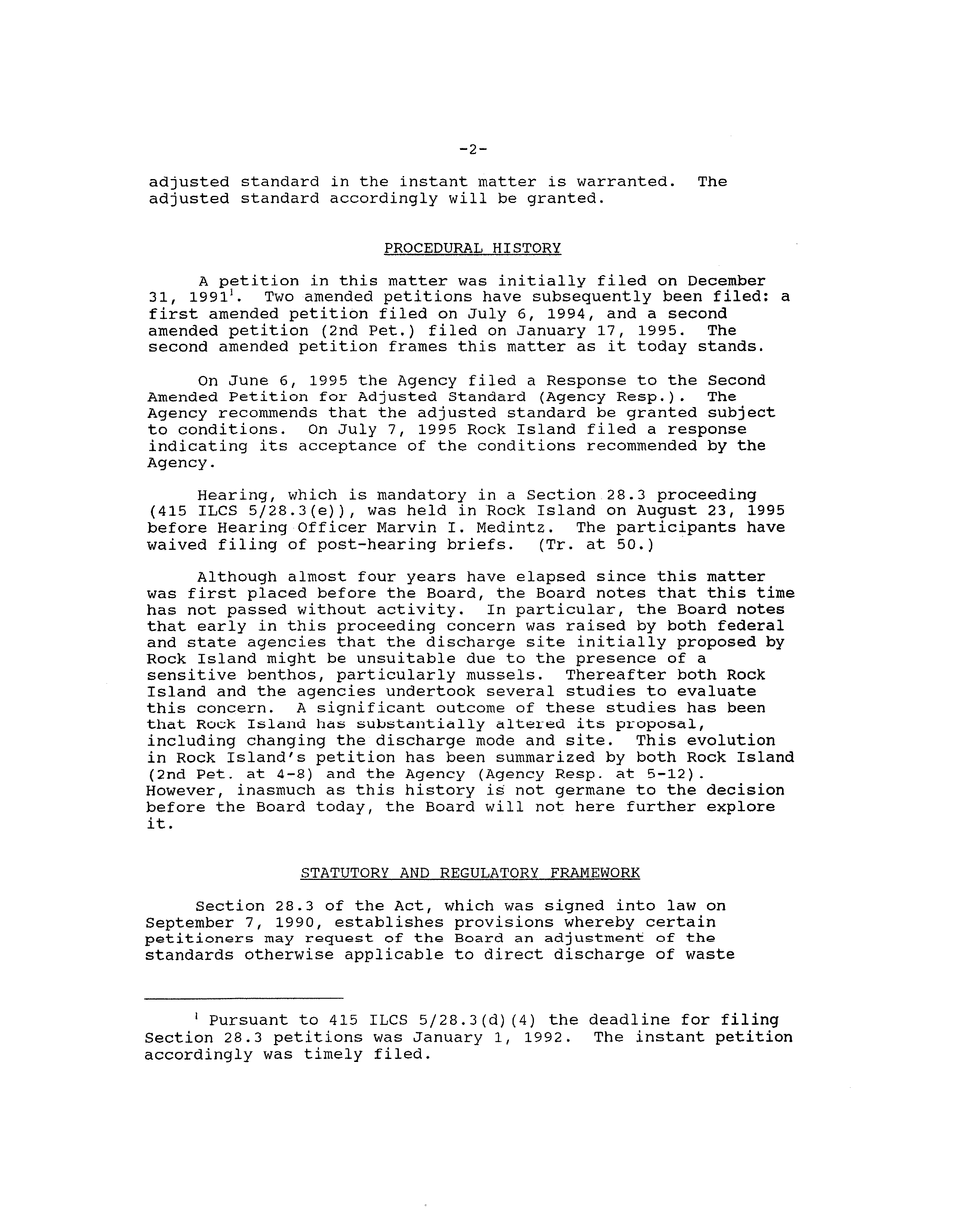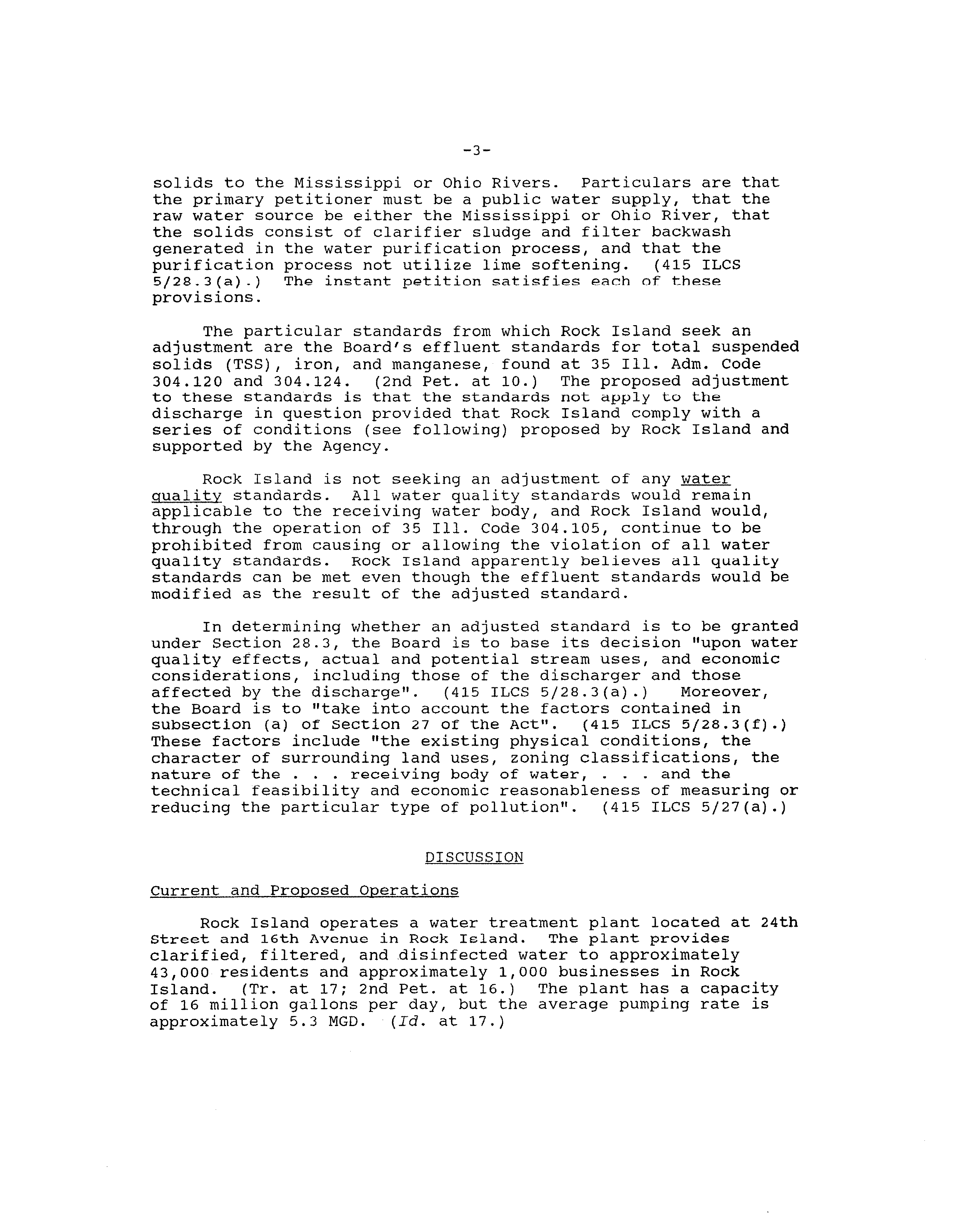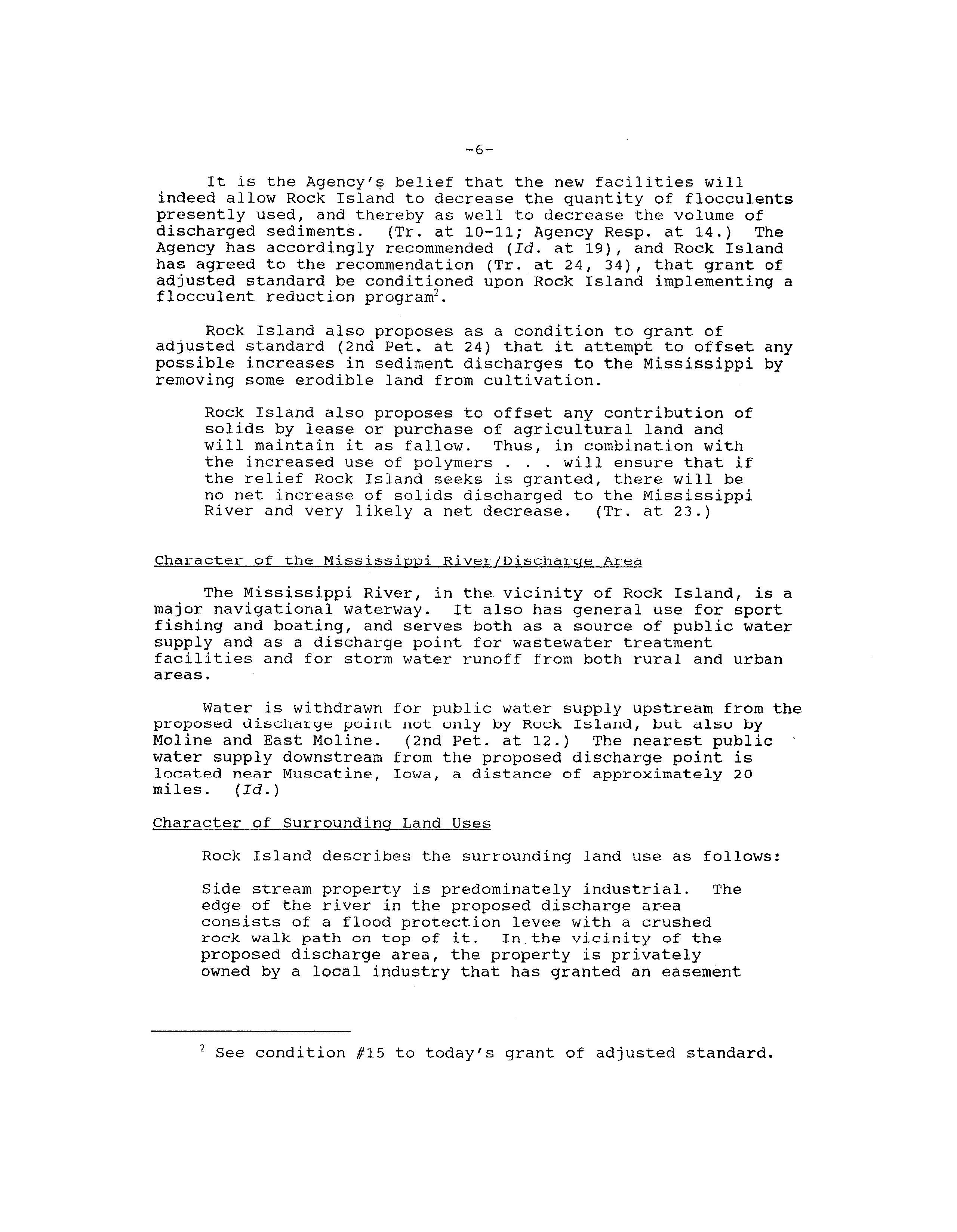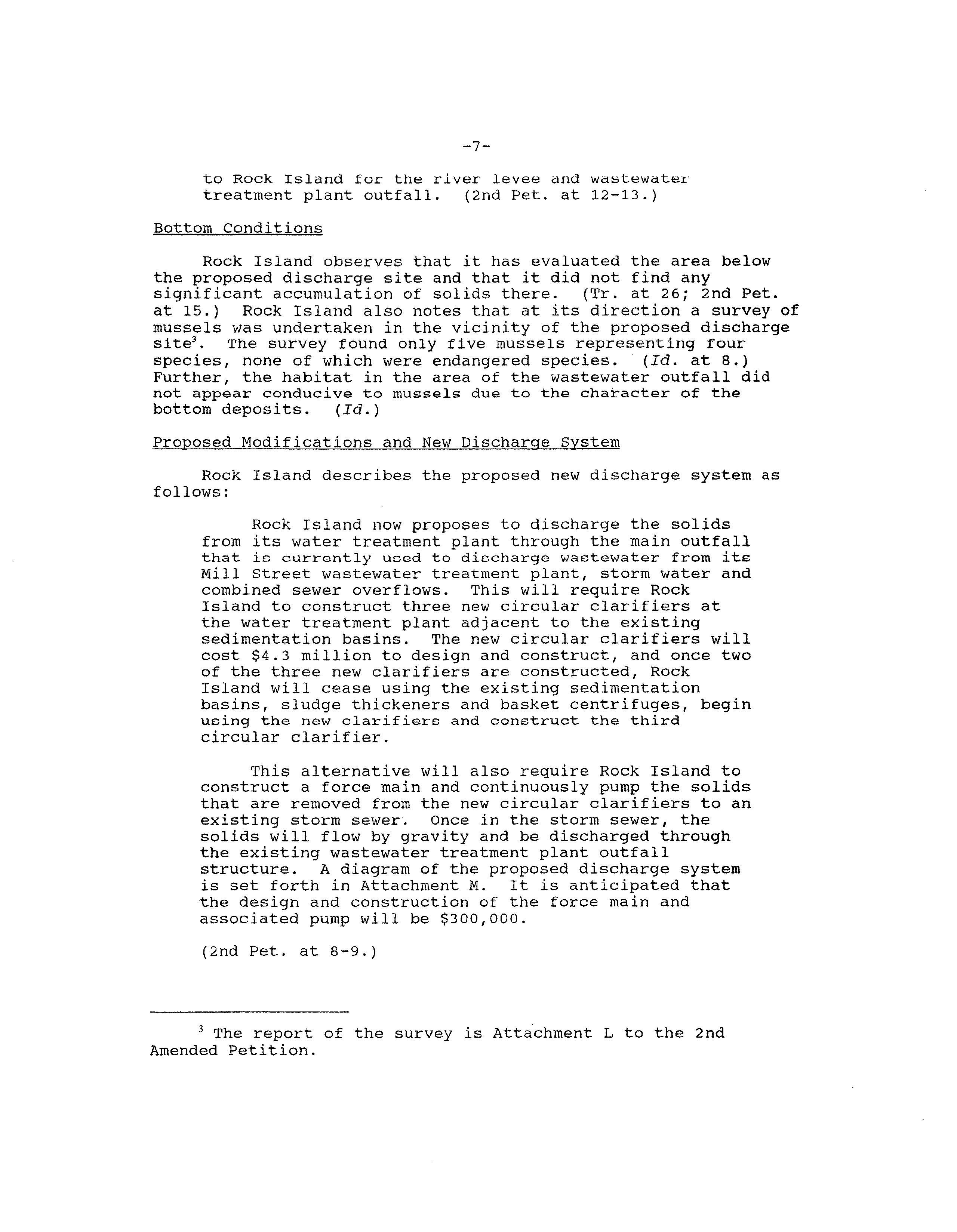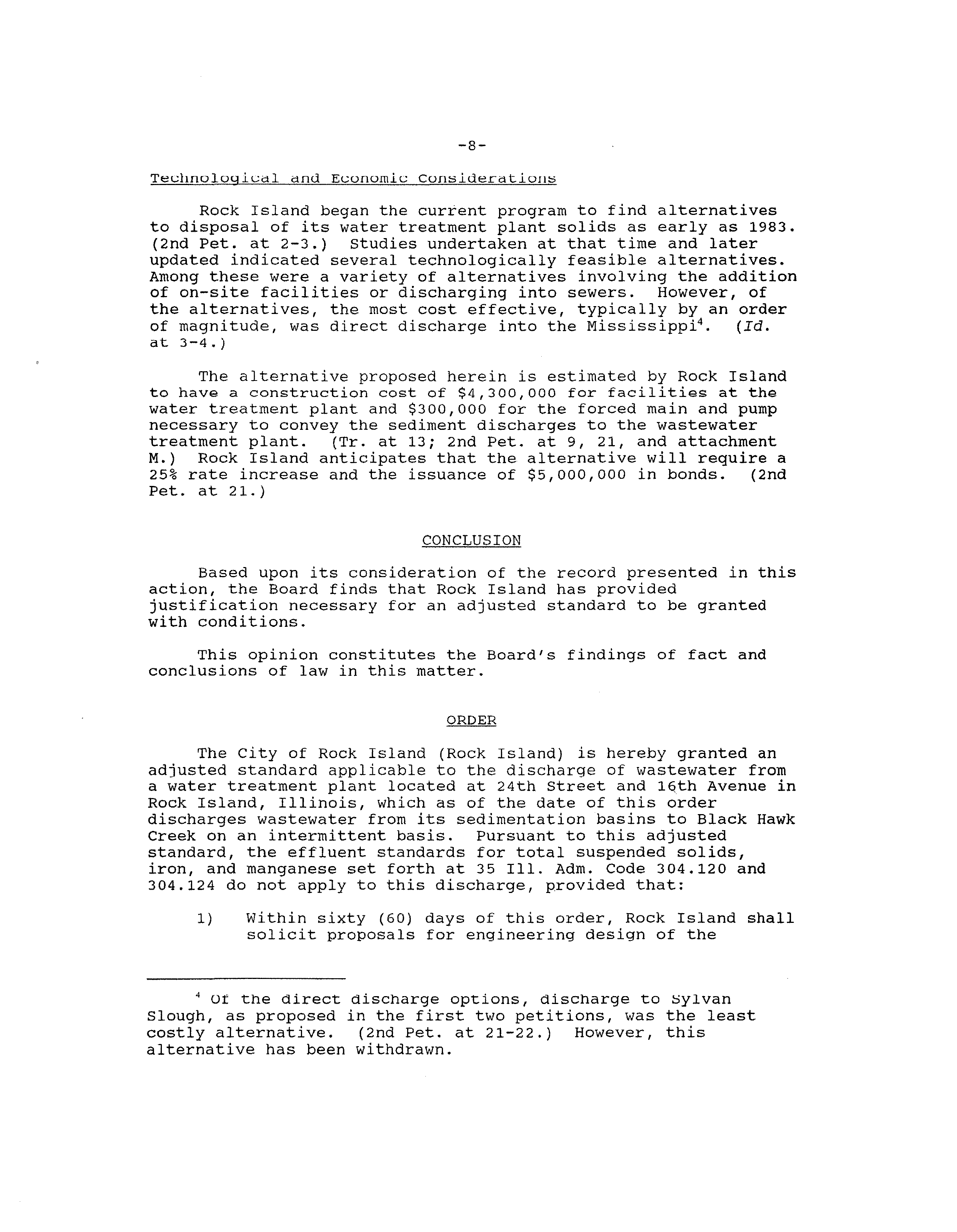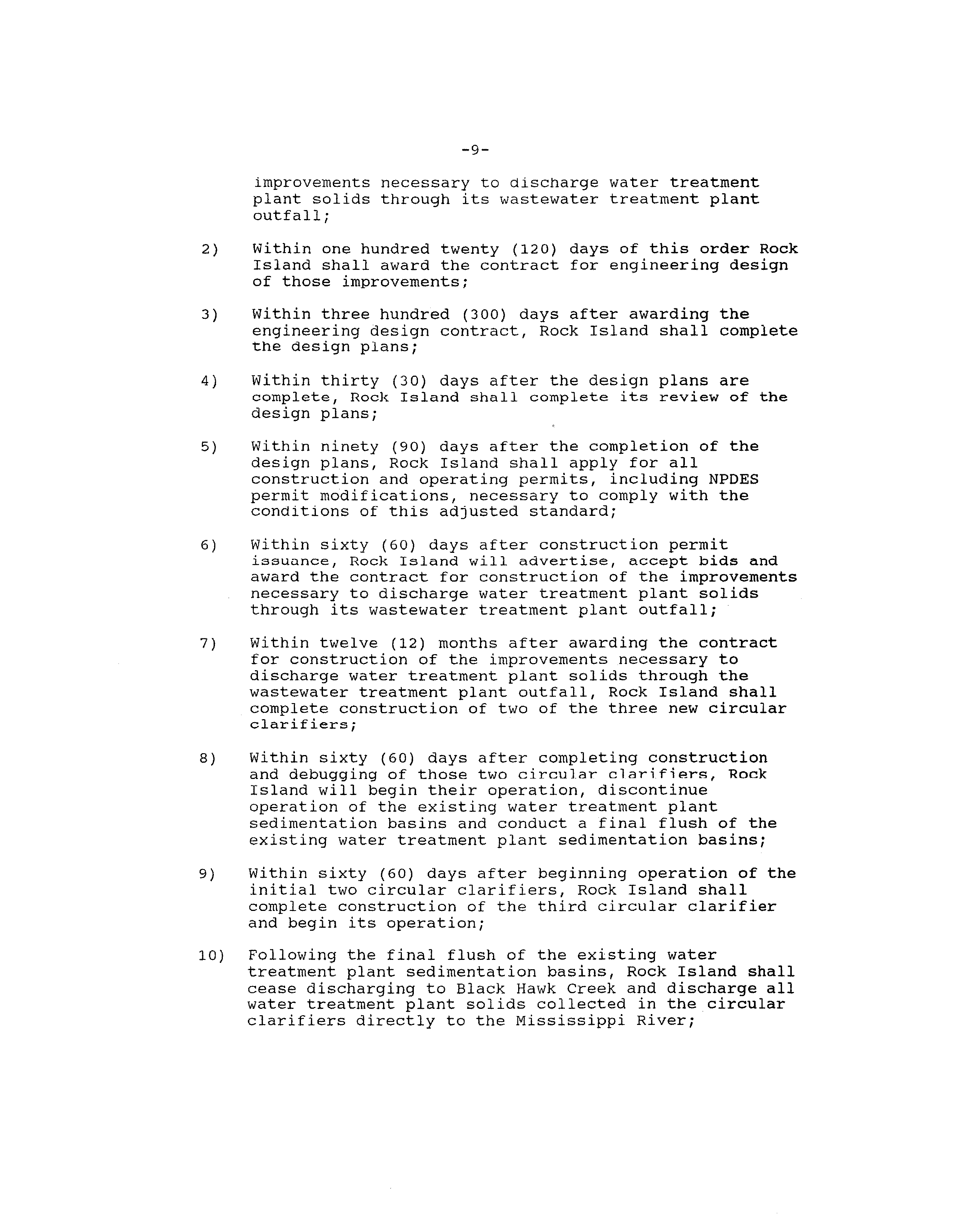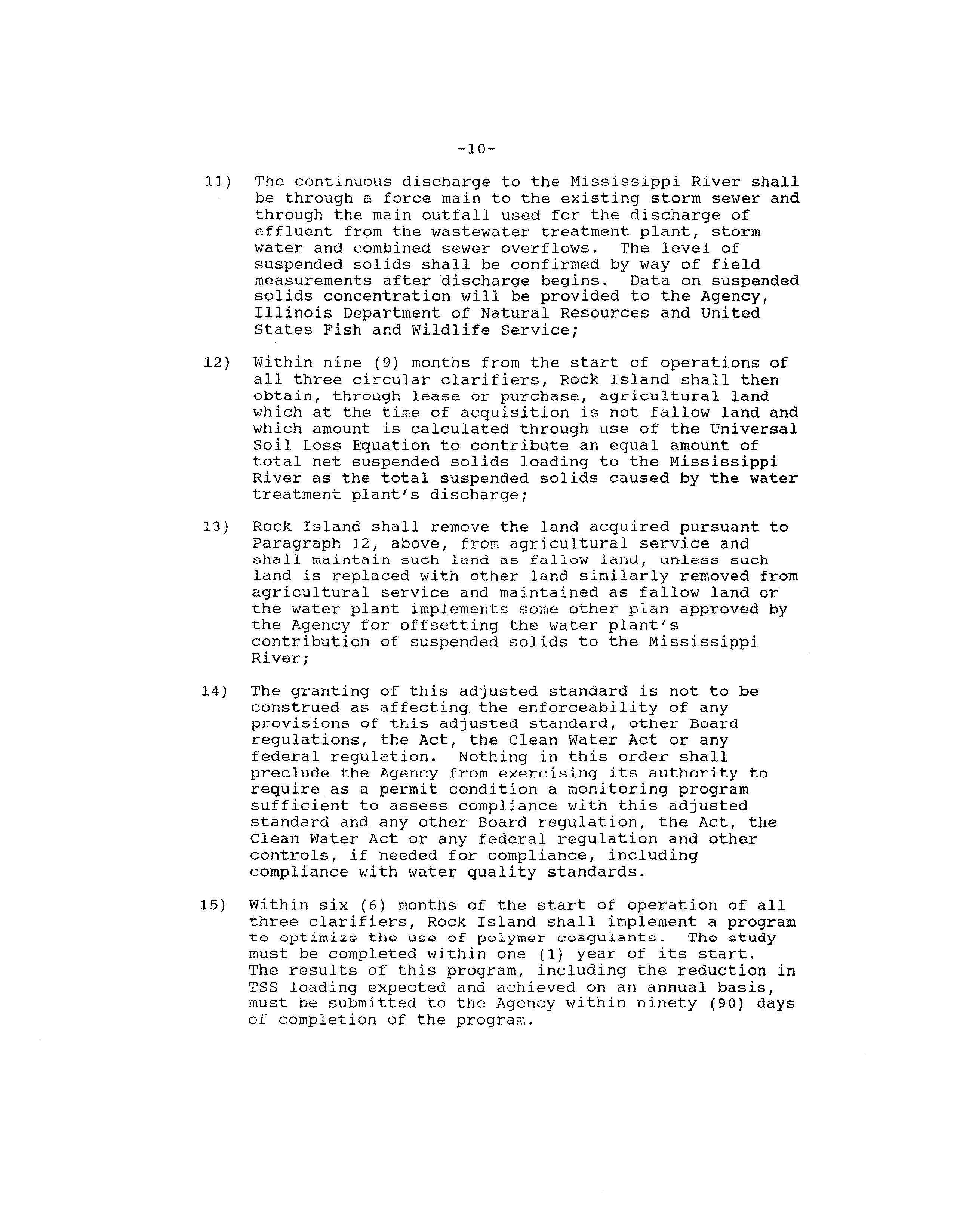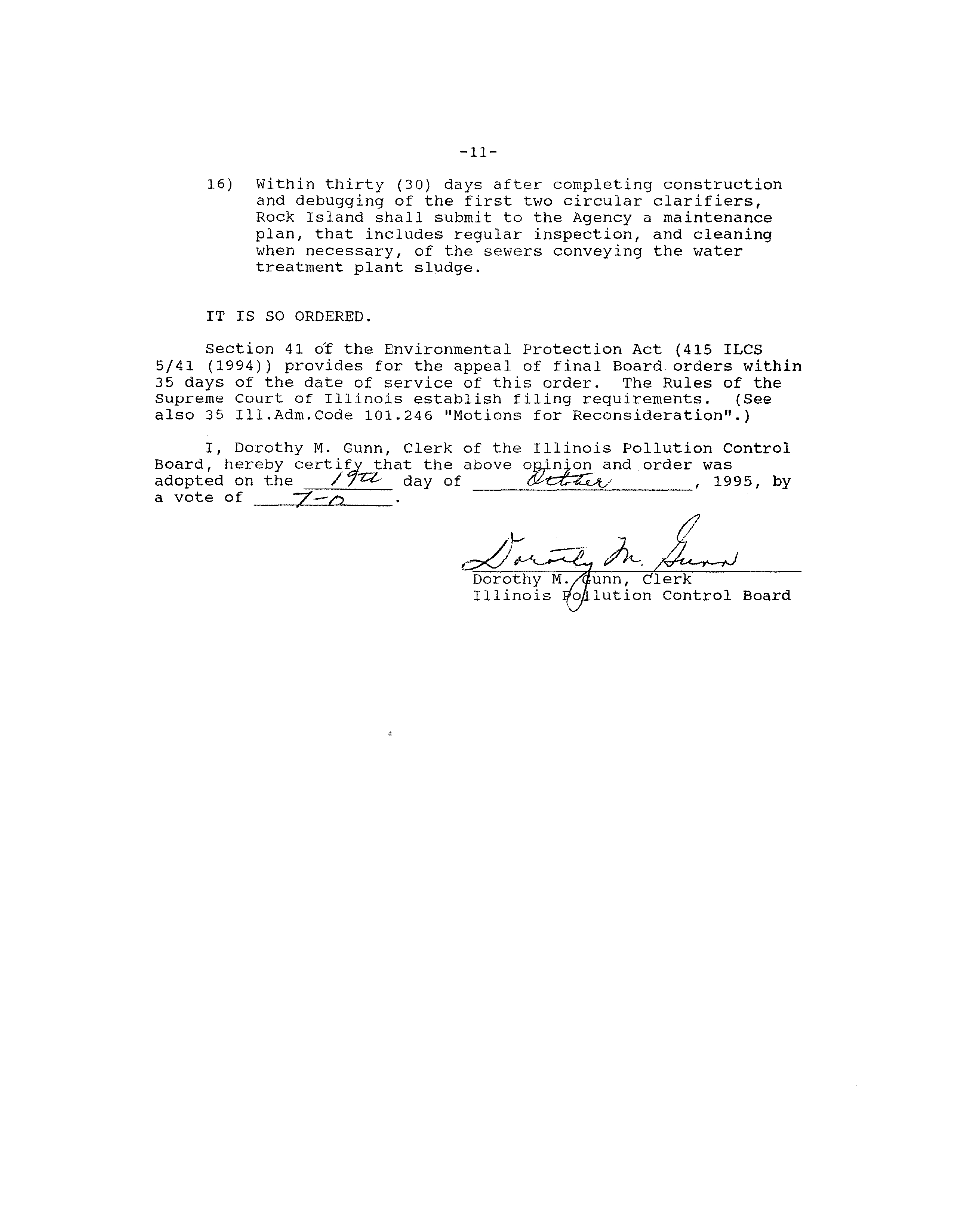ILLINOIS POLLUTION CONTROL BOARD
October
19,
1995
IN THE MATTER OF:
PETITION OF THE CITY OF
)
AS 91-13
ROCK ISLAND FOR AN
)
(Adjusted Standard
-
Water)
ADJUSTED STANDARD FROM
)
35
ILL. ADM. CODE 304
)
MARK
LATHAN,
OF
GARDNER,
CARTON
&
DOUGLAS,
APPEARED ON
BEHALF
OF
THE
CITY OF ROCK
ISLAND;
LISA MORENO APPEARED ON
BEHALF OF THE
ILLINOIS
ENVIRONMENTAL
PROTECTION AGENCY.
OPINION AND ORDER OF THE
BOARD
(by R.C.
Flemal):
This matter comes before the Board upon
a petition for
adjusted standard filed by the City of Rock Island
(Rock Island).
Rock Island
requests
an
adjusted standard from the Board effluent
regulations at 35
Ill. Adm.
Code 304 as applied to the wastewater
discharges from Rock Island’s water treatment plant.
The
petition is brought pursuant to the provisions concerning
discharge of solids to the Mississippi or Ohio Rivers found at
Section 28.3 of the Environmental Protection Act
(Act)
(415 ILCS
5/1
et seq.
(1994)).
The
Board’s
responsibility
in
this matter arises from the
Act.
The Board
is charged therein to “determine, define and
implement the environmental control standards applicable in the
State of Illinois”
(415 ILCS 5/5(b)),
as well as to “grant
***
an
adjusted standard for persons who can justify such an adjustment”
(415 ILCS 5/29.1(a)).
More generally, the Board’s responsibility
in this matter is based on the system of checks and balances
integral to Illinois environmental governance:
the Board
is
charged with the rulemaking and principal adjudicatory functions,
and the Illinois Environmental Protection Agency
(Agency)
is
responsible for administering the Act and the Board’s
regulations.
In a Section 28.3 proceeding the Agency also has
responsibility to review proposals and, where the Agency so
dee~ns,
participate
as a joint petitioner.
(416
ILCS
28,3(b).)
Although the Agency has not joined as a petitioner
in the instant
proceeding,
it has otherwise been an active participant.
Based
upon
the
record
before
it
and
upon
review
of
the
factors involved
in the consideration of adjusted standards,
the
Board finds that Rock Island has demonstrated that grant of
an
—2—
adjusted standard
in the instant matter
is warranted.
The
adjusted standard accordingly will be granted.
PROCEDURAL HISTORY
A petition in this matter was initially filed on December
31,
1991~.
Two amended petitions have subsequently been filed:
a
first amended petition filed on July
6,
1994,
and
a second
amended petition
(2nd Pet.)
filed
on January
17,
1995.
The
second amended petition frames this matter as
it today stands.
On June
6,
1995 the Agency filed
a Response to the Second
Amended Petition for Adjusted Standard
(Agency Resp.).
The
Agency recommends that the adjusted standard be granted subject
to conditions.
On July
7,
1995 Rock Island filed
a response
indicating
its acceptance of the conditions recommended by the
Agency.
Hearing, which
is mandatory
in
a Section28.3 proceeding
(415 ILCS 5/28.3(e)),
was held
in Rock Island on August 23,
1995
before Hearing Officer Marvin
I.
Medintz.
The participants have
waived filing of post—hearing briefs.
(Tr.
at 50.)
Although almost four years have elapsed since this matter
was first placed before the Board,
the Board notes that this time
has not passed without activity.
In particular, the Board notes
that early in this proceeding concern was raised by both federal
and state agencies that the discharge site initially proposed by
Rock Island might be unsuitable due to the presence of
a
sensitive benthos, particularly mussels.
Thereafter both Rock
Island and the agencies undertook several studies to evaluate
this concern.
A significant outcome of these studies has been
that Rock Island
has
substantially altered its proposal,
including changing the discharge mode and site.
This evolution
in Rock Island’s petition has been summarized by both Rock Island
(2nd Pet.
at
4—8)
and the Agency
(Agency Resp.
at
5-12).
However,
inasmuch as this history
is
not germane to the decision
before the Board today,
the Board will not here further explore
it.
STATUTORY
AND
REGULATORY
FRAMEWORK
Section
28.3 of the Act, which was signed into
law on
September
7,
1990,
establishes provisions whereby certain
petitioners may request of
the Board an adjustment
of
the
standards otherwise applicable to direct discharge of waste
Pursuant to 415 ILCS 5/28.3(d)
(4)
the deadline for filing
Section 28.3 petitions was January
1,
1992.
The instant petition
accordingly was timely filed.
—3—
solids to the Mississippi
or Ohio Rivers.
Particulars are that
the primary petitioner must be a public water supply, that the
raw water source be either the Mississippi or Ohio River,
that
the solids consist of clarifier sludge and filter backwash
generated in the water purification process,
and that the
purification process not utilize lime softening.
(415 ILCS
5/28~3(a))
The
instant petition
satisfies each nf these
provisions.
The particular standards from which Rock Island seek an
adjustment are the Board’s effluent standards for total suspended
solids
(TSS),
iron,
and manganese, found at
35 Ill.
Adm. Code
304.120 and 304.124.
(2nd Pet.
at
10.)
The proposed adjustment
to
these
standards
is
that the standards not apply to
the
discharge
in
question
provided
that
Rock
Island
comply
with
a
series
of
conditions
(see
following)
proposed
by
Rock
Island
and
supported
by
the
Agency.
Rock
Island
is
not
seeking
an
adjustment
of
any
water
quality
standards.
All
water
quality
standards
would
remain
applicable
to
the
receiving
water
body,
and
Rock
Island
would,
through
the
operation
of
35
Ill.
Code
304.105,
continue
to
be
prohibited
from
causing
or
allowing
the
violation
of
all
water
quality standards.
Rock
Island apparently believes all
quality
standards can be met even though the effluent standards would be
modified as the result of the adjusted standard.
In determining whether an adjusted standard is to be granted
under Section 28.3,
the Board
is to base
its decision “upon water
quality effects,
actual and potential stream uses,
and economic
considerations,
including those of the discharger and those
affected
by the discharge”.
(415 ILCS 5/28.3(a).)
Moreover,
the Board is to “take into account the factors contained
in
subsection
(a)
of Section
27
of the Act”.
(415 ILCS
5/28.3(f).)
These factors include “the existing physical conditions,
the
character
of surrounding land uses,
zoning classifications,
the
nature
of
the
.
.
.
receiving body of water,
-
.
.
and
the
technical feasibility and economic reasonableness of measuring or
reducing the particular type of pollution”.
(415 ILCS 5/27(a).)
DISCUSSION
Current and Proposed Operations
Rock Island operates
a water treatment plant located at 24th
Street and 16th Avenue in Rock Island.
The plant provides
clarified,
filtered,
and
disinfected
water
to
approximately
43,000
residents
and
approximately
1,000
businesses
in
Rock
Island.
(Tr.
at
17;
2nd Pet.
at
16.)
The plant has
a capacity
of
16 million gallons per day,
but the average pumping rate
is
approximately 5.3 MGD.
(Id.
at
17.)
—4—
The raw water source for the treatment plant
is the
Mississippi River.
The raw water
is delivered to the water
treatment plant via
a pumping station located at 24th Street
in
Rock
Island.
(2nd
Pet,
at
17.)
The raw water
is subject to various treatments.
The
first
treatment consists
of primary clarification throuqh rapid mix
flocculation and sedimentation aided by the addition of alum and
lime.
(2nd Pet.
at
17.)
The clarified water
is then passed
through gravity filters for filtration of remaining suspended
solids.
(Id.)
The
riltered water
is finally disintected and
fluoridated before being routed
into on-site storage or the
distribution
system.
(Id.)
Rock Island’s operation generates two waste streams:
filter
backwash water generated when the gravity filters are cleaned,
and sediments from the sedimentation and flocculation basins.
(2nd Pet.
at
17.)
The filter backwash water
is currently sent to
one of Rock Island’s wastewater treatment plants; this practice
is not proposed to
be altered.
(Id.)
The second waste stream
is currently disposed of via
a
combination
of landfilling and flushing.
Nineteen percent of the
sediment basin wastes arc dcwatcrod and landfillcd.
(2nd Pot.
at
17.)
The remaining 81
are flushed twice a year into Black Hawk
Creek,
a small tributary of the Rock River.
(Id.)
Rock Island
estimates that the sedimentation basin solids accumulate at the
rate of approximately 4800 pounds per day.
(Tr.
at
18.)
Under
its instant petition,
Rock Island proposes to
continuously discharge the sedimentation basin solids to the Rock
Island wastewater treatment plant located at 1300 Mill Street in
Rock
Island.
There the waste stream would be continuously
discharged directly
to
Mississippi
River via
the same outlet used
to discharge treated effluent from the treatment plant.
(2nd
Pet. at 12,
17.)
Water quality Effects
Rock Island contends that there would be no measurable
adverse environmental impact caused by the proposed discharge.
(2nd Pet.
at
25.)
The Agency indicates that it anticipates
no
adverse impact.
(Agency Resp.
at 20,
22.)
Rock Island bases its
conclusion in part on the contention that “half of the
constituents discharged are derived from the Mississippi River
water
and
will
be simply returned to
it through continuous
discharge,
which will
rapidly return the mixture to background
levels”.
(2nd Pet.
at
25.)
However,
Rock
Island
has
attempted
to
quantify
the
average
discharge
concentrations
and
effluent
quality
to
be
expected
if
the
requested
relief
is
granted.
The
estimation
was
made
by
assuming
that
effluent
of
the
quality
current
for
the
Mill
Street
—5—
wastewater treatment plant would be combined with discharges from
the
water
treatment
plant
at
the
current
levels
of
sediment
production.
(Tr.
at
42-43,
46;
2nd
Pet.
at
13-14.)
For
each
parameter
of
interest
the
data
suggests
that
concentrations
in
the
combined
effluent
would
be
less
than
the
respective
General
Use Water Quality standard:
Water
Current
Combined
Quality
Effluent
Effluent
Standard
Parameter
(mq/L)
(mq/L)
(mg/L)
Barium
0.04
0.42
5.0
Copper
0.005
0.0056
0.28
Iron
0.077
0.97
l.0~
Lead
0.02
0.019
0.148
Manganese
0.018
0.045
Nickel
0.01
0.011
1.0
TSS
15.0
86
Zinc
0.005
0.031
1.0
As dissolved
iron;
effluent concentrations
are
f
or
total
iron
Rock Island thus contends that the combined water treatment
plant/wastewater treatment plant discharge would meet water
quality standards at the end of pipe;
the Agency indicates that
Rock Island’s data supports this conclusion
(Agency Resp.
at
16).
Nevertheless,
both Rock Island and the Agency observe that
utilization
of
a
Zone of Initial Dilution
(ZID)
may be necessary
to insure consistent compliance with the water quality standards.
(2nd Pet.
at
10; Agency Resp.
at
16.)
Rock Island has
a ZID
defined
in
its
current
NPDES
permit,
and the
Ayexicy
notes
that.
“certainly
the
Agency
will
reexamine
the
issue
of
mixing
and
ZIDS
in
connection
with
the issuance of
a modification
of
the
current
permit
to reflect the addition of the water treatment discharge”
(Agency
Resp.
at
16).
The
Agency
also
observes,
however,
that
of
the parameters of interest, only copper and lead would qualify
for
a ZID because these are the two parameters
for which an acute
toxicity
standard
has
been
established.
(Id.)
Reduction
in
Flocculent
and
Sediment
Loading
Under current operations approximately half
of the solids
generated
in
the
sedimentation/flocculation
basins
consist
of
aluminum
and
calcium hydrates resulting
from the alum—lime
additions.
(2nd
Pet.
at
18.)
In
order
to
decrease
the
amount
of
sediment
generated,
Rock
Island
originally
proposed
to
investigate
the
use
of
polymers
as
an
alternative
flocculent,
noting that the results cannot be determined until the new
facilities necessary to allow
for continuous discharge are
constructed
and
operational.
(Id.)
—6—
It
is
the
Agency’s
belief
that
the
new
facilities
will
indeed
allow
Rock
Island
to
decrease
the
quantity
of
flocculents
presently used, and thereby as well to decrease the volume of
discharged
sediments.
(Tr.
at
10-11;
Agency
Resp.
at
14.)
The
Agency has accordingly recommended
(Id.
at 19), and Rock Island
has
agreed
to
the
recommendation
(Tr.
at
24,
34),
that
grant
of
adjusted
standard
be conditioned upon Rock Island implementing a
flocculent reduction program2.
Rock
Island
also
proposes
as
a
condition
to
grant
of
adjusted
standard
(2nd
Pet.
at
24)
that
it
attempt
to
offset
any
possible
increases
in
sediment
discharges
to
the Mississippi by
removing
some
erodible
land
from
cultivation.
Rock
Island
also
proposes
to
offset
any
contribution
of
solids
by
lease
or
purchase
of agricultural
land and
will
maintain
it
as
fallow.
Thus,
in
combination
with
the
increased
use
of
polymers
-
.
.
will
ensure
that
if
the relief Rock
Island seeks
is granted,
there will be
no
net
increase
of
solids
discharged
to
the
Mississippi
River
and
very
likely
a
net
decrease.
(Tr.
at
23.)
Character
of
the
Mississippi
River/Discharge
Area
The Mississippi
River,
in the vicinity of Rock Island,
is
a
major navigational waterway.
It also has
general
use
for
sport
fishing and boating,
and serves both as a source of public water
supply and as
a discharge point for wastewater treatment
facilities
and
for
storm
water
runoff
from
both
rural
and
urban
areas.
Water
is
withdrawn
for
public
water
supply
upstream
from
the
proposed
discharge
point
not
only
by
Rock
Island,
buL
also
by
Moline
and
East
Moline.
(2nd
Pet.
at
12.)
The nearest public
water supply downstream from the proposed discharge point
is
located near Muscatine,
Iowa,
a distance of approximately
20
miles.
(Id.)
Character of Surrounding Land Uses
Rock Island describes the surrounding
land use as follows:
Side
stream
property
is
predominately
industrial.
The
edge of the river
in the proposed discharge area
consists of
a flood protection levee with a crushed
rock walk path on top
of it.
Inthe
vicinity of
the
proposed
discharge
area,
the
property
is
privately
owned by a
local industry that has granted an easement
2
See
condition
#15
to
today’s
grant
of
adjusted
standard.
—7—
to Rock Island for the river levee and
wastewater
treatment
plant
outfall.
(2nd
Pet.
at
12—13.)
Bottom Conditions
Rock
Island
observes
that
it
has
evaluated
the
area
below
the proposed discharge site and that
it
did
not
find
any
significant accumulation of solids there.
(Tr.
at
26; 2nd Pet.
at
15.)
Rock Island also
notes
that
at
its
direction
a
survey
of
mussels was undertaken
in the vicinity of the proposed discharge
site3.
The survey found only five mussels representing
four
species,
none
of
which
were
endangered
species.
(Id.
at 8.)
Further,
the
habitat
in
the
area
of
the
wastewater
outfall
did
not
appear
conducive
to
mussels
due
to
the
character
of
the
bottom
deposits.
(Id.)
Proposed
Modifications
and
New
Discharge
System
Rock Island describes the proposed new discharge system as
follows:
Rock
Island
now
proposes
to
discharge
the
solids
from its water treatment plant through the main outfall
that
is currently used to discharge wactewater from its
Mill Street wastewater treatment plant,
storm water and
combined sewer overflows.
This will require Rock
Island to construct three new circular clarifiers at
the water treatment plant adjacent to the existing
sedimentation
basins.
The new circular clarifiers will
cost
$4.3
million to design and construct,
and once two
of the three new clarifiers are constructed,
Rock
Island will cease using the existing sedimentation
basins,
sludge thickeners and basket centrifuges,
begin
using the
new
clarifiers and construct the third
circular clarifier.
This alternative will also require Rock Island to
construct
a force main and continuously pump the solids
that are removed from the new circular clarifiers to an
existing storm sewer.
Once
in the storm sewer,
the
solids will
flow by gravity and be discharged through
the existing wastewater treatment plant outfall
structure.
A diagram of the proposed discharge system
is set forth in Attachment M.
It
is anticipated that
the design and construction of the force main and
associated pump will
be $300,000.
(2nd Pet,
at 8-9.)
~ The report of the survey
is Attachment
L to the
2nd
Amended Petition.
—8—
Technological and
Economic
Considerations
Rock Island began the current program to find alternatives
to disposal
of its water treatment plant solids as early as
1983.
(2nd Pet.
at 2-3.)
Studies undertaken at that time
and
later
updated indicated several technologically feasible alternatives.
Among these were
a variety of alternatives involving the addition
of on—site facilities or discharging into sewers.
However,
of
the alternatives, the most cost effective,
typically by an order
of magnitude,
was direct discharge into the Mississippi4.
(Id.
at
3—4.)
The
alternative
proposed
herein
is
estimated
by
Rock
Island
to
have
a
construction
cost
of
$4,300,000
for
facilities
at
the
water
treatment
plant
and
$300,000
for
the
forced
main
and
pump
necessary to convey the sediment discharges to the wastewater
treatment
plant.
(Tr.
at
13;
2nd
Pet.
at
9,
21,
and
attachment
M.)
Rock
Island
anticipates
that
the
alternative
will
require
a
25
rate increase and the issuance of $5,000,000
in bonds.
(2nd
Pet.
at
21.)
CONCLUSION
Based
upon its consideration of the record presented
in this
action,
the
Board
finds
that
Rock
Island
has
provided
justification necessary for an adjusted standard to be granted
with
conditions.
This
opinion
constitutes
the
Board’s
findings
of
fact
and
conclusions
of
law
in
this
matter.
ORDEP.
The
City
of
Rock
Island
(Rock
Island)
is
hereby
granted
an
adjusted standard applicable to the discharge
of wastewater from
a water treatment plant located
at 24th Street and l~thAvenue in
Rock Island,
Illinois, which as
of the date of this order
discharges wastewater from its sedimentation basins to Black Hawk
Creek on an intermittent basis.
Pursuant to this adjusted
standard,
the
effluent
standards
for
total
suspended
solids,
iron,
and manganese set forth at
35
Ill.
Adm.
Code
304.120
and
304.124
do not
apply to this discharge, provided that:
1)
Within
sixty
(60)
days
of this order, Rock Island shall
solicit
proposals
for
engineering
design
of
the
~‘
or
ti-xe direct discharge options,
discharge to Sylvan
Slough,
as
proposed
in
the
first
two
petitions,
was
the
least
costly
alternative.
(2nd
Pet.
at
21-22.)
However,
this
alternative
has
been
withdrawn.
—9—
improvements necessary to discharge water treatment
plant
solids
through
its
wastewater
treatment
plant
outfall;
2)
Within
one
hundred
twenty
(120)
days
of
this
order
Rock
Island shall award the contract for engineering design
of those improvements;
3)
Within three hundred
(300)
days after awarding the
engineering
design
contract,
Rock
Island
shall
complete
the
design
plans;
4)
Within
thirty
(30)
days
after
the
design
plans
are
complete,
Rock
Island
shall
complete
its
review
of
the
design plans;
5)
Within
ninety
(90)
days after the completion of the
design
plans,
Rock
Island
shall
apply
for
all
construction and operating permits,
including NPDES
permit modifications,
necessary to comply with the
conditions of this
adjusted
standard;
6)
Within sixty
(60)
days after construction
permit
issuance,
Rock Island will advertise,
accept bids and
award the contract for construction of the improvements
necessary to discharge water treatment plant solids
through
its
wastewater
treatment
plant
outfall;
7)
Within
twelve
(12)
months
after
awarding
the
contract
for
construction
of
the
improvements
necessary
to
discharge water treatment plant
solids through the
wastewater treatment plant outfall,
Rock Island shall
complete construction of two of the three new circular
clarifiers;
8)
Within sixty
(60)
days after completing construction
and debugging of those two circular clarifiers,
Rock
Island will
begin their operation, discontinue
operation of the existing water treatment plant
sedimentation basins and conduct a final flush of the
existing water treatment plant sedimentation basins;
9)
Within sixty
(60)
days after beginning operation of the
initial two circular clarifiers,
Rock Island shall
complete construction of the third circular clarifier
and begin its operation;
10)
Following the final flush of the existing water
treatment plant sedimentation basins,
Rock Island shall
cease discharging to Black Hawk Creek and discharge all
water treatment plant solids collected
in the circular
clarifiers directly to the Mississippi
River;
—10—
11)
The continuous discharge to the Mississippi
River shall
be through a
force main to the existing storm sewer and
through the main outfall
used for the discharge
of
effluent
from the wastewater treatment plant,
storm
water and combined sewer overflows.
The
level of
suspended solids shall be confirmed by way
of field
measurements after discharge begins.
Data on suspended
solids concentration will be provided to the Agency,
Illinois Department of Natural Resources and United
States Fish and Wildlife Service;
12)
Within nine
(9)
months from the start
of operations of
all three circular clarifiers, Rock Island shall then
obtain,
through lease or purchase,
agricultural land
which at the time of acquisition
is
not fallow land and
which amount
is calculated through use of the Universal
Soil Loss Equation to contribute an equal amount of
total net suspended solids loading to the Mississippi
River as the total suspended solids caused by the water
treatment plant’s discharge;
13)
Rock Island shall remove the land acquired pursuant to
Paragraph
12,
above,
from agricultural service and
shall maintain
such land
as
fallow land,
unless such
land
is replaced with other
land similarly removed from
agricultural service and maintained as fallow land or
the water plant implements some other plan approved by
the Agency for offsetting the water plant’s
contribution of suspended solids to the Mississippi
River;
14)
The granting of this adjusted standard is not to be
construed as affecting the enforceability
of any
provisions
of
this
adjusted
standard,
other
board
regulations,
the Act, the Clean Water Act
or any
federal regulation.
Nothing in this order shall
preclude the ~genr.y from exercising
its authority to
require as
a permit condition
a monitoring program
sufficient to assess compliance with this adjusted
standard and any other Board regulation,
the Act,
the
Clean Water Act or any federal regulation and other
controls,
if needed for compliance,
including
compliance with water quality standards.
15)
Within six
(6)
months of the start of operation
of all
three clarifiers,
Rock Island shall implement
a program
to optimize
the use of polymer
coagulantc.
The study
must
be
completed
within
one
(1)
year of
its
start.
The results of this program,
including the reduction in
TSS loading expected and achieved on an annual basis,
must be submitted to the Agency within ninety
(90)
days
of
completion
of the program
—11—
16)
Within thirty
(30)
days after completing construction
and debugging of the first two circular clarifiers,
Rock Island shall submit to the Agency
a maintenance
plan,
that includes regular inspection,
and cleaning
when necessary,
of
the sewers conveying the water
treatment plant sludge.
IT
IS
SO
ORDERED.
Section
41
of the Environmental Protection Act
(415 ILCS
5/41
(1994))
provides
for the appeal of final Board orders within
35 days of the date
of service of this order.
The Rules of the
Supreme Court of Illinois establish filing requirements.
(See
also
35 Ill.Adm.Code 101.246
“Motions for Reconsideration”.)
I,
Dorothy
N.
Gunn, Clerk of the Illinois Pollution Control
Board,
hereby certi~,ythat the above o~,in~onand order was
adopted on the
/7~-
day of
_____________________,
1995, by
a vote of
_______________
Dorothy M./~unn, Clerk
Illinois ~34lution
Control
Board


